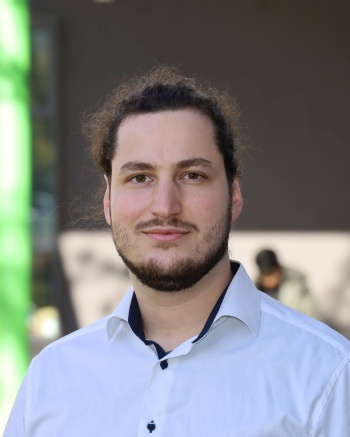Niklas Thoma

M.Sc. Niklas Thoma
Mehrkörperdynamik (IWTM)
Current projects
ABSORBED - Acoustic Black holeS fOR viBration rEDuction
Duration: 01.12.2024 to 31.08.2027
Increasing demands are being placed on dynamically loaded systems in terms of durability and comfort. This is particularly evident regarding the NVH (noise, vibration and harshness) behavior of the machines that leads to noise pollution, which can cause mental and physical problems. A general goal research in this field is to effectively avoid vibrations with minimal use of materials, low additional mass and low space requirements.
Conventional vibration reduction methods generally use various stiffening and damping concepts to reduce broadband excitations, whereby a high additional mass often has to be introduced for low frequency ranges in order to achieve sufficient amplitude reduction. If economic aspects and the reliability of vibration damping systems are also taken into account, conventional, established damping concepts reach their limits.
As part of the planned project, the theoretical concept of structure calming with acoustic black holes, which has been tested on a laboratory scale, is to be implemented in practice and made applicable.
The term “acoustic black hole” (ASL) describes a passive method of vibration damping. The starting point is a thin-walled structure in which the thickness of the plate decreases consistently according to a power law as a function of the plate length. This local decrease in stiffness leads to a uniform reduction in shaft velocity. When considering an ideal ASL system with a structure whose thickness tends towards zero, the wave velocity also reaches zero at the end point, thus avoiding reflection. As a result, energy accumulates at this point and can be effectively dissipated by damping effects.
The use of acoustic black holes can be a significant disadvantage as they affect the basic structure by reducing the thickness of the material. This reduction in thickness can in turn significantly limit the protective functions of structures such as enclosures. The static properties of the components are strongly influenced, which represents a major challenge for the design. Consequently, the integration of acoustic black holes has a significant impact on the design of components, which often need to undergo extensive redesign to ensure the required structural integrity and safety.
In order to meet the aforementioned challenges, it makes sense not to integrate the ASL directly into the basic structure of the components, but to apply them as ASL damping elements to the surface of the structure. This approach makes it possible to achieve the desired damping effects without reducing the material thickness of the basic structure and thus restricting potential protective functions.
2025
Book chapter
Housing design for medical imaging systems - a comprehensive approach to acoustic and vibro-acoustic optimisation
Thoma, Niklas; Woschke, Elmar
In: Proceedings of DAS/DAGA 2025 , 2025 - Berlin : Deutsche Gesellschaft für Akustik e.V. (DEGA) ; Dau, Torsten, S. 717-720
Leisere Bildgebung durch Strukturverbesserungen: Optimierung der Versteifungsrippen im CT-Gehäuse
Thoma, Niklas; Woschke, Elmar
In: Tagungsband - Proceedings "Fortschritte der Akustik - DAGA 2024" , 2024 - Berlin : Deutsche Gesellschaft für Akustik e.V. ; Peissig, Jürgen *1960-* . - 2025, S. 717-720
2024
Abstract
Optimized interventional MRI patient table design proposal
Ehses, Maik; Thoma, Niklas; Maune, Holger
In: ESMRMB 2024 - ESMRMB, Artikel 277 [Meeting: 2024 ESMRMB 40th Annual Scientific Meeting, Barcelona, 2 - 5 October 2024]
2023
Book chapter
Preliminary study of acoustic black holes implemented in CT/MRI housings including validation experiments
Thoma, Niklas; Duvigneau, Fabian; Juhre, Daniel; Woschke, Elmar
In: INTER-NOISE and NOISE-CON Congress and Conference Proceedings - Washington, DC : Institute of Noise Control Engineering . - 2023, S. 995-1994
Akustische Charakterisierung eines Computertomographen
Thoma, Niklas; Duvigneau, Fabian; Juhre, Daniel; Woschke, Elmar
In: Tagungsband, DAGA 2023 - 49. Jahrestagung für Akustik , 2023 - Berlin : Deutsche Gesellschaft für Akustik e.V. ; Estorff, Otto *1957-*, S. 174-177 [Tagung: 49. Jahrestagung für Akustik, DAGA 2023, Hamburg, 06. - 09. März 2023]
Experimentelle Konzeptstudien zur Anwendbarkeit akustischer schwarzer Löcher und Metamaterialien
Thoma, Niklas; Duvigneau, Fabian; Juhre, Daniel; Trenner, Michael; Woschke, Elmar
In: Aggregate- und Antriebsakustik - 12. Magdeburger Symposium, 28. und 29. Juni 2023 : Tagungsband - Magdeburg : Universitätsbibliothek, Artikel 15, insges. 16 S. [12. Magdeburger Symposium Aggregate- und Antriebsakustik, 2023]
2022
Abstract
Demonstration of versatile anatomically designed instrument alignment units for the remote operated RIGS instrument micropositioning system
Odenbach, Robert; Fomin, Ivan; Thoma, Niklas; Hensen, Bennet; Wacker, Frank; Rose, Georg
In: Symposium: 13th Interventional MRI Symposium 2022, Leipzig, October 14-15, 2022, 13th International Interventional MRI Symposium - Leipzig . - 2022, S. 39
Multifunctional, elastic and non-metallic Bowden-cable coupling mechanism for the modularization and remote control of the RIGS instrument micropositioning system
Thoma, Niklas; Odenbach, Robert; Fomin, Ivan; Hensen, Bennet; Wacker, Frank; Rose, Georg
In: Symposium: 13th Interventional MRI Symposium 2022, Leipzig, October 14-15, 2022, 13th International Interventional MRI Symposium - Leipzig . - 2022, S. 110
2020
Abstract
Remotely controllable phantom rotation device for cross-calibration at 7T
Mattern, Hendrik; Odenbach, Robert; Thoma, Niklas; Godenschweger, Frank; Speck, Oliver
In: ISMRM 28th annual ISMRM virtual conference & exhibition, 08. - 14. August 2020: SMRT 29th annual meeting, Concord, CA./ ISMRM Annual Meeting & Exhibition, 2020, 2020, Poster 3372[ISMRM 28th annual ISMRM virtual conference & exhibition, virtual, 08. - 14. August 2020]
2019
Peer-reviewed journal article
Remotely controllable phantom rotation system for ultra-high field MRI to improve cross calibration
Odenbach, Robert; Thoma, Niklas; Mattern, Hendrik; Friebe, Michael
In: Current directions in biomedical engineering - Berlin: De Gruyter, Bd. 5 (2019), 1, S. 429-431